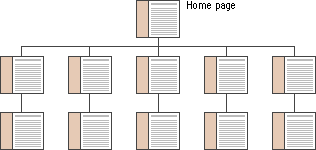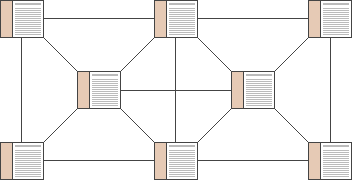 | |
Basic information structuresWeb sites are built around basic structural themes. These fundamental architectures govern the navigational interface of the Web site and mold the user's mental models of how the information is organized. Three essential structures can be used to build a Web site: sequences, hierarchies, and webs. SequencesThe simplest way to organize information is to place it in a sequence. Sequential ordering may be chronological, a logical series of topics progressing from the general to the specific, or alphabetical, as in indexes, encyclopedias, and glossaries. Straight sequences are the most appropriate organization for training sites, for example, in which the reader is expected to go through a fixed set of material and the only links are those that support the linear navigation path: 
More complex Web sites may still be organized as a logical sequence, but each page in the main sequence may have links to one or more pages of digressions, parenthetical information, or information on other Web sites: 
HierarchiesInformation hierarchies are the best way to organize most complex bodies of information. Because Web sites are usually organized around a single home page, hierarchical schemes are particularly suited to Web site organization. Hierarchical diagrams are very familiar in corporate and institutional life, so most users find this structure easy to understand. A hierarchical organization also imposes a useful discipline on your own analytical approach to your content, because hierarchies are practical only with well-organized material. 
WebsWeblike organizational structures pose few restrictions on the pattern of information use. In this structure the goal is often to mimic associative thought and the free flow of ideas, allowing users to follow their interests in a unique, heuristic, idiosyncratic pattern. This organizational pattern develops with dense links both to information elsewhere in the site and to information at other sites. Although the goal of this organization is to exploit the Web's power of linkage and association to the fullest, weblike structures can just as easily propagate confusion. Ironically, associative organizational schemes are often the most impractical structure for Web sites because they are so hard for the user to understand and predict. Webs work best for small sites dominated by lists of links and for sites aimed at highly educated or experienced users looking for further education or enrichment and not for a basic understanding of a topic. 
|
|
|